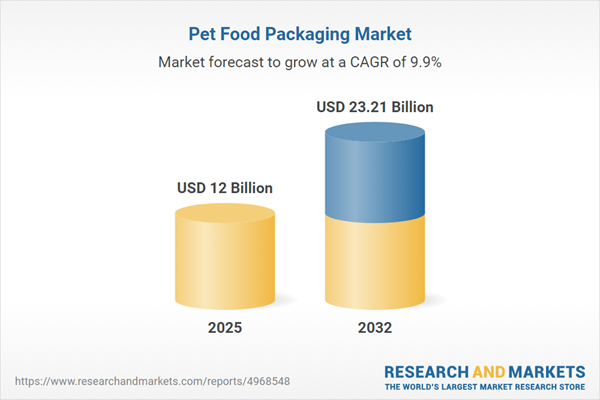Speak directly to the analyst to clarify any post sales queries you may have.
The pet food packaging market is being reshaped as manufacturers respond to evolving consumer preferences, regulatory pressures, and the need for both sustainability and innovation in packaging solutions. Senior executives seeking to differentiate their brands, secure resilient supply chains, and achieve sustainable growth will find this research essential for informed strategic planning.
Market Snapshot: Pet Food Packaging Market Growth and Trends
The global pet food packaging market grew from USD 10.89 billion in 2024 to USD 12.00 billion in 2025 and is projected to reach USD 23.21 billion by 2032, registering a CAGR of 9.91%. Growth is being propelled by the demand for sustainable packaging, advances in material innovation, regulatory shifts, and a pronounced consumer focus on product safety and transparency. As e-commerce accelerates and consumer expectations rise, packaging manufacturers are prioritizing recyclable materials, advanced barrier technologies, and intelligent packaging features across key regions.
Scope & Segmentation of the Pet Food Packaging Market
This report offers comprehensive coverage of market dynamics, including a detailed segmentation and competitive overview. It identifies drivers, restraints, opportunities, and competitive moves specific to diverse pet food packaging segments.
- Packaging Materials: Glass, metal, paper and paperboard (including corrugated board and paperboard box), and plastic across various product tiers and sustainability profiles.
- Packaging Types: Flexible, rigid, and semi-rigid solutions to address requirements for durability, cost-effectiveness, and environmental impact.
- Packaging Formats: Bags, bottles, cans, pouches, trays, and tubs, supporting freshness, resealability, and consumer convenience.
- Packaging Technologies: Active, aseptic, modified atmosphere, and vacuum packaging to enhance shelf life, product quality, and traceability.
- Animal Types: Birds, cats, dogs, fish & aquatic, reptiles, and small animals, with packaging adapted to specific product and storage needs.
- Sales Channels: Convenience stores, hypermarkets & supermarkets, online retail, specialty pet stores, and veterinary clinics to support varied retail strategies.
- Regional Coverage: Americas (United States, Canada, Mexico, Brazil, Argentina, Chile, Colombia, Peru), Europe, Middle East & Africa (including the UK, Germany, France, Russia, and more), and Asia-Pacific (China, India, Japan, Australia, South Korea, Indonesia, Thailand, Malaysia, Singapore, Taiwan).
- Industry Players: Companies analyzed include Amcor plc, Berry Global Group, Inc., Mondi plc, Sealed Air Corporation, Huhtamaki Oyj, Smurfit Kappa Group plc, Sonoco Products Company, DS Smith plc, Winpak Ltd., and Crown Holdings, Inc.
Key Takeaways for Decision Makers
- Consumer preferences are accelerating a transition to eco-friendly packaging, compelling manufacturers to invest in recyclable and renewable materials over conventional options.
- Digital advancements, such as QR code integration and variable data printing, are elevating brand transparency while improving traceability within global supply chains.
- Smart packaging features, from active barrier coatings to nitrogen flushing, are enhancing product freshness without sacrificing sustainability objectives, positioning brands for greater consumer trust.
- Regional differences in regulatory regimes and infrastructure are catalyzing localized innovations, making adaptive packaging portfolios essential for global competitiveness.
- Cross-sector partnerships—especially with upstream suppliers and material scientists—are accelerating the adoption of new packaging formats while reducing compliance risks and operational bottlenecks.
Tariff Impact: Navigating United States Packaging Material Tariffs
Newly enacted tariffs in the United States on imported packaging materials, including aluminum and specific plastics, are increasing operational costs for pet food manufacturers. These external pressures are prompting procurement leaders to consider alternative sourcing, strategic warehousing, and regional partnerships to maintain margin and continuity. The compounding effect is influencing manufacturing strategies and supply chain policies industry-wide.
Methodology & Data Sources
This research incorporates primary interviews with senior executives across packaging suppliers, brand owners, and regulatory bodies, complemented by analysis of academic publications, patent databases, and trade reports. Quality assurance protocols ensured alignment and reliability of insights through rigorous data validation.
Why This Report Matters for Senior Executives
- Identify high-risk supply chain vulnerabilities and develop resilient procurement strategies responsive to regulatory and economic volatility.
- Leverage detailed segmentation to pinpoint materials, formats, and technologies best suited to each target consumer group and channel.
- Benchmark against industry leaders and adapt to regional packaging standards and emerging sustainability priorities for long-term differentiation.
Conclusion: Strategic Insights for Sustainable Growth
This report delivers an actionable roadmap for leveraging transparency, technology, and adaptive packaging to achieve operational resilience and competitive strength. Executives can move forward confidently, ensuring pet food packaging strategies address changing market, regulatory, and consumer dynamics.
Additional Product Information:
- Purchase of this report includes 1 year online access with quarterly updates.
- This report can be updated on request. Please contact our Customer Experience team using the Ask a Question widget on our website.
Table of Contents
3. Executive Summary
4. Market Overview
7. Cumulative Impact of Artificial Intelligence 2025
Companies Mentioned
The companies profiled in this Pet Food Packaging market report include:- Amcor plc
- Berry Global Group, Inc.
- Mondi plc
- Sealed Air Corporation
- Huhtamaki Oyj
- Smurfit Kappa Group plc
- Sonoco Products Company
- DS Smith plc
- Winpak Ltd.
- Crown Holdings, Inc.
Table Information
| Report Attribute | Details |
|---|---|
| No. of Pages | 191 |
| Published | November 2025 |
| Forecast Period | 2025 - 2032 |
| Estimated Market Value ( USD | $ 12 Billion |
| Forecasted Market Value ( USD | $ 23.21 Billion |
| Compound Annual Growth Rate | 9.9% |
| Regions Covered | Global |
| No. of Companies Mentioned | 11 |









